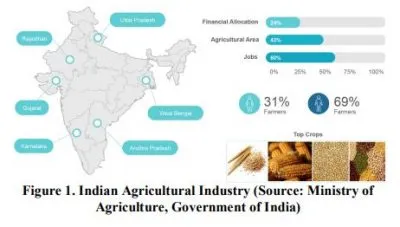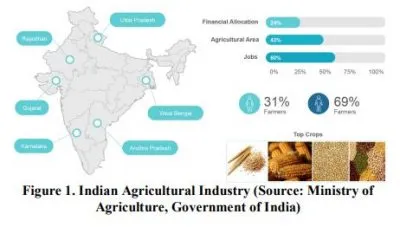Indian Agriculture – Breaking Stories and Reforms
Blog: NASSCOM Official Blog
The projected increase in world population from 7.6Bn in 2018 to 9.8Bn in 2050 has received a great deal of attention. In addition, rapid rate of urbanisation is expected in the coming years with approximately 66% of the world’s population expected to live in urban areas by 2050. Therefore 40% of water demand in 2030 is unlikely to be met, and more than 20% of arable land is already degraded. According to Food and Agricultural Organisation of the United Nations 70 % of rural households still depend on agriculture for their livelihood, with 82% farmers being small and marginal. Despite India being the largest producer (25% of global production), consumer (27% of world consumption) and importer (14%) of pulses in the world, India has still many growing concerns. Indian agriculture has various factors like climate change, soil conditions, storage & warehousing that come into play for a high crop failure rate and farmer distress. There is a dire need to improve the agricultural practices and introduce a blend of Agritech and Biotech to address the farmland and crop productivity issues, continuing a sustainable and diversified agricultural sector.
Since India is one of the major contributors to the global food basket, sustaining food security in India holds larger implications. Although fluctuating, the agricultural growth rate over the years reflects the resilience of the sector to the erratic climatic conditions, market volatility, embracing technology and the strategic policy efforts. Though the application of digital technology in agriculture has been instrumental in promoting data generation, weather sensing and warehousing, however adoption in the Pre-harvest remains significantly less.

Sustainable Agriculture through Mini-Chromosomal Technology
With the emerging technologies changing the agricultural landscape in the years ahead, perhaps one of the most significant advents in agricultural technology is bundled in a tiny package. A mini chromosome is a small structure within a cell that includes very little genetic material but can, in layman’s terms, hold a lot of information. Using mini chromosomes, agricultural geneticists can add dozens and may be even hundreds of traits to a plant. These traits can be quite complex, such as drought tolerance and nitrogen use. However, the most intriguing part of mini-chromosomal technology is that a plant’s original chromosomes are not altered in any way. That results in faster regulatory approval and wider acceptance from consumers. Agricultural biotechnology has helped farmers to boost their productivity while allowing much more optimal use of resources. A classic example in this context would be the herbicide tolerant varieties which is commercially available too, have accelerated an ongoing shift to conservation tillage (minimising cultivation) practices that decreases soil erosion, lesser usage of water and reduce machinery use that decreases fuel and greenhouse emissions. On the other hand, the insect resistant varieties have reduced the need for synthetic chemical pesticides with a lower impact on biodiversity. Research indicates that when ploughed organic fields are compared with no-till fields on the same farm and tended by the same farmer, no-till practices uses only one-third as much fossil fuel and use land more efficiently. Thus, by adopting more sustainable management practices, agriculture can also play a great role in soil carbon sequestration.
A significant portion of the food is lost post-harvest through poor transportation systems, poor storage conditions and inadequate warehousing. Notably, a lot of exotic or high-quality agricultural products ripen correctly but get spoiled prior consumption. However, bio-technologists and agriculturists are of the opinion that the mini-chromosal technology which can deliver multiple stacked traits in a single crop can eventually help to reduce these losses. One of the interesting examples about the first genetically engineered crop product approved for sale was a tomato in which ripening had been modified through the introduction of antisense genes.
For innovation and entrepreneurship to drive the transformation in Indian agriculture, it would be important to address the issues and create an enabling environment to drive the sector. In addition to the above one of the barriers to call -to-action is the resistance towards biotech crops. Despite the economic benefit reaped by producers of commodity crops very few varieties are grown commercially. Besides developing technologies for promoting intensification, the country must give greater attention to the development of a road-map as the best fir to facilitate agricultural diversification particularly towards intensive production of fruits, vegetables, flowers and other high value crops that are expected to increase income growth and generate effective demand for food.
The post Indian Agriculture – Breaking Stories and Reforms appeared first on NASSCOM Community |The Official Community of Indian IT Industry.
